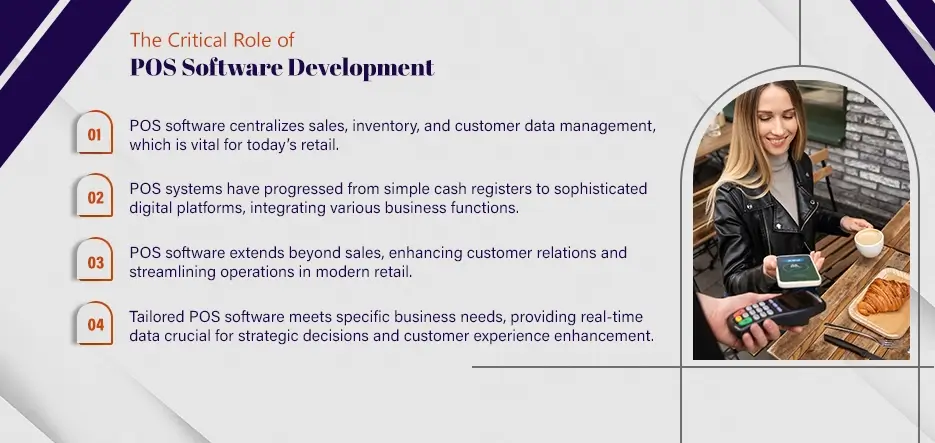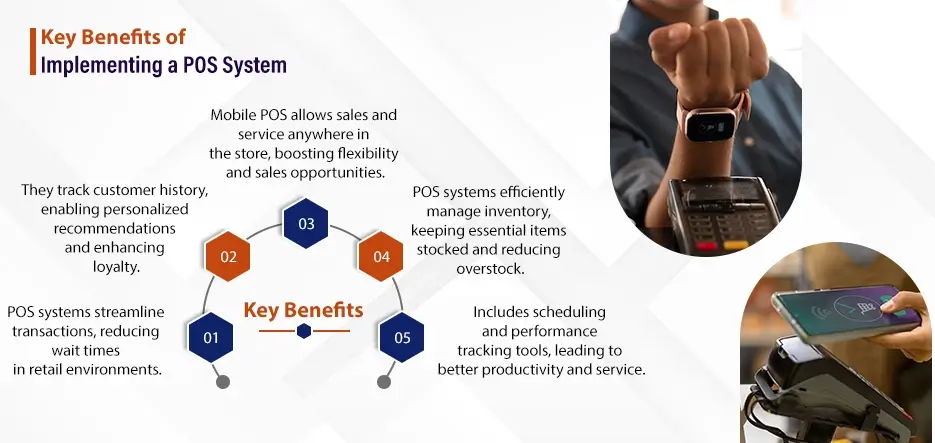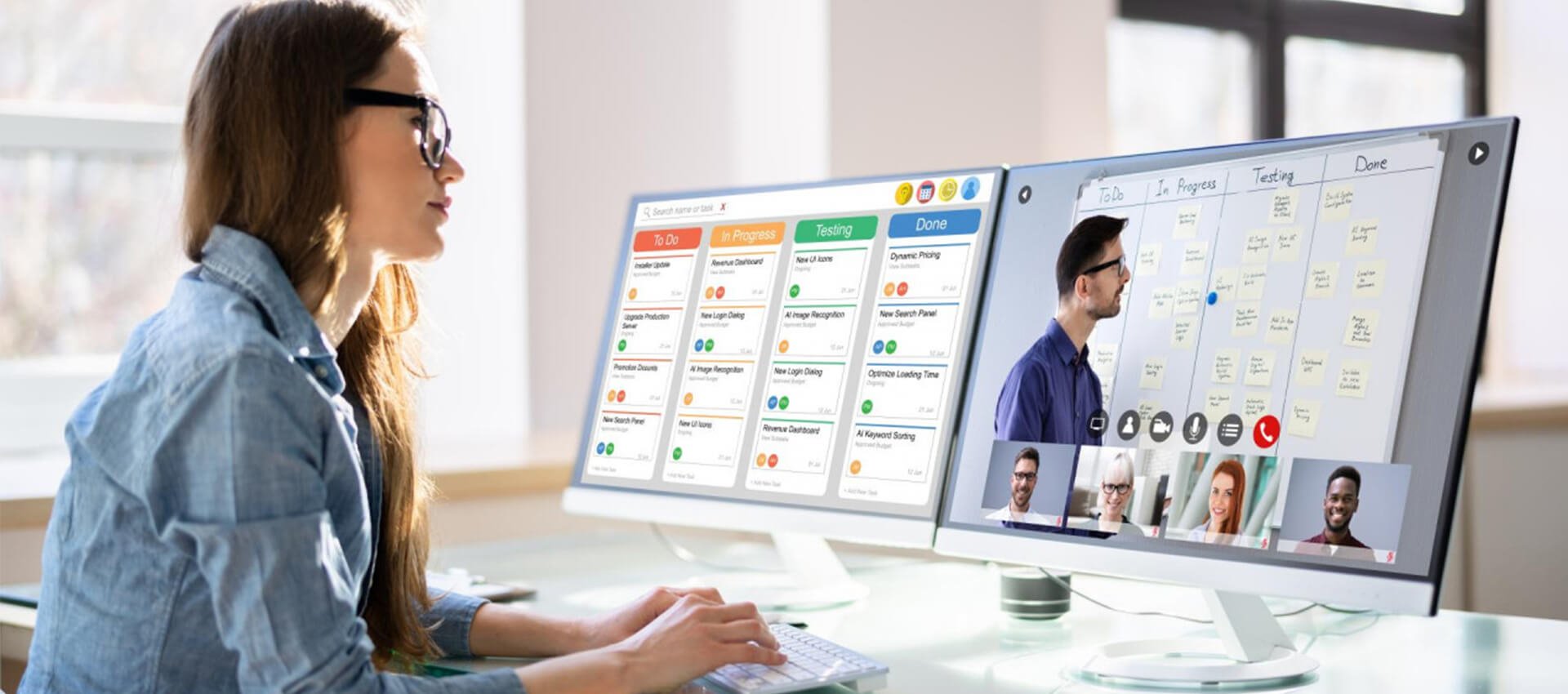Table of Contents
POS software development is at the heart of this change. It’s a key part of today’s retail management. This software makes sales processes smoother. It also provides full solutions for inventory control, understanding customer data, and financial reports.
POS systems have changed from simple cash registers to complex digital tools. Initially, POS systems were mostly mechanical, just for recording sales. But, as technology grew, they turned into sophisticated software platforms. Now, POS systems do more than process sales. They combine different parts of business management, like keeping track of inventory, managing customer relationships, and analyzing data.

This change came from the need for better and more accurate business operations. A study by the National Retail Federation shows that 68% of retailers put payment technology as a top priority in their budgets. This fact shows how important POS systems are in today’s retail world.
Its Importance in Modern Retail
POS software is vital in today’s digital retail operations. It’s a versatile tool that handles sales transactions and customer connections. The role of POS software in modern retail is very important. It’s not just a tool for making sales.
One of the main benefits of POS software is that it gives real-time data. This is crucial for making smart business choices. A report by Forrester says that 57% of businesses think real-time data is very important for improving customer experience. This focus on up-to-date information is what makes modern POS systems stand out.
Also, POS software development is now more tailored to specific business needs. Custom POS software development allows businesses to shape the software to fit their specific operations. This customization is key in a market where businesses want to be unique and personal.
POS software development has been a big change-maker in retail. It has grown from a simple tool for recording sales to a complete tool for managing business. This reflects the wider change towards digital in the industry. As businesses keep changing, POS software will play a bigger role in making operations more efficient and improving customer experiences.
What is POS Software?
POS software, standing for Point of Sale software, is essential in today’s retail and hospitality sectors. It does more than a traditional cash register. It combines one system of sales, inventory control, and customer relationship management (CRM). It’s the central point where sales, customer data, and stock meet to make business operations smoother.
At its core, POS software is where sales happen. But it’s more than a sales tool. It includes inventory tracking, updating stock levels instantly, and sales reporting, offering insights into business health. It also handles customer data, aiding in customized marketing and better customer service.
The Role of POS Software in Streamlining Business Operations
POS software transforms how businesses work. It makes various operations more efficient and effective. Here’s how:
- Enhancing Efficiency in Sales Transactions: It speeds up checkouts, cutting customer wait times. This is key in busy periods. Harvard Business Review found that businesses using advanced POS systems cut customer wait times by up to 40%.
- Inventory Management: A big plus of POS software is real-time inventory management. It takes the guesswork out of stock control, letting businesses quickly adjust to stock changes.
- Data-Driven Decision Making: POS software gathers lots of data per transaction. This is crucial for informed decisions on pricing, promotions, and stock.
- Enhanced Customer Experience: Many POS systems have CRM features, allowing personalized customer interactions based on their history and preferences. This can boost customer loyalty and repeat business.
- Streamlining Multiple Business Operations: Modern POS systems combine various functions, from sales to employee management. This alignment leads to smoother and more efficient processes.
- Customization and Scalability: Businesses can shape their POS systems for specific needs with custom enterprise software development. This means the software can evolve with the business, adapting over time.
Don’t Wait, Revolutionize your Point-of-Sale Experience Now!
Point of Sale Software for Small Business
POS software development is increasingly focused on meeting the unique needs of small businesses. These customized systems handle tasks like sales processing and inventory management in an easy-to-use interface.
Small businesses often compete with larger ones. Custom POS solutions help level the playing field. A POS software development company that works with small businesses knows they need scalable and adaptable systems. The best custom software development companies create straightforward POS systems that require little training and can be customized for each small business.
For example, a small boutique might need a POS system with strong inventory management software capabilities. It would process sales and track inventory, alerting the owner about low stocks and offering insights into buying trends.
Hardware Components of a POS System
In POS software development, the role of hardware is crucial. These components are the tangible parts that make the POS system work well. Knowing about these key hardware pieces is important for businesses looking into point-of-sale software development or planning to hire a custom software development company in USA.
- POS Terminal: This is the core of a POS system. It processes transactions and is a computer-based version of old cash registers with more features. Modern POS terminals can be fixed units or mobile devices like tablets.
- Barcode Scanner: This tool speeds up the checkout by quickly reading product barcodes. It improves accuracy in sales and inventory control, reducing mistakes.
- Receipt Printer: Essential for giving customers their transaction records, receipt printers are common in retail. They also print reports like daily sales totals.
- Customer Display System: This screen shows customers transaction details like prices and total cost. It helps make the transaction clear and builds trust.
Integrating Hardware with POS Software for Enhanced Performance
Merging hardware with POS software is vital in custom software development outsourcing. The system is efficient, strong, and easy to use when they work together smoothly.
- Synchronization: Good POS systems sync hardware and software for accurate, real-time data.
- Customization: Different businesses have different needs. Custom POS solutions meet these needs. A company specializing in custom software development can create a POS system with the right hardware for each business.
- Scalability: As businesses grow, their POS system should too. Combining scalable hardware with adaptable software means the POS system can grow with the business.
- Data Security: With hardware and software combined, keeping data safe is crucial. POS systems must follow data protection rules to secure customer and business information.
- User Experience: User-friendly software and hardware make the POS system easier. This leads to faster transactions and happier customers.
- Maintenance and Support: When a professional POS software development company integrates the system, maintenance and support are easier. This means any problems can be fixed quickly, reducing downtime.
How to Create Your Own POS Software
Here’s an easy-to-follow guide for those looking into POS software development or seeking point-of-sale software solutions.
Identifying Business Requirements and Market Research
First, figure out what your business specifically needs. This involves knowing the unique challenges and demands your business faces every day.
- Assess Your Business Needs: Look at where your current system falls short. What issues are you facing? This could include problems with tracking inventory or slow customer service.
- Conduct Market Research: See what systems similar businesses use. This helps you understand which features are useful and might not be needed for your business.
Steps in Developing Custom POS Software
With a clear idea of your needs, you’re ready to start making the POS software. This might be when you decide to hire a custom software development company.
- Choose the Right Development Partner: Pick a company experienced in POS software and who understands your industry.
- Design Phase: Work with the developers to plan the software. This includes the user interface, features, and how it will work with your current setup.
- Development Phase: The developers will build the software based on your plans. Stay in touch and give feedback to make sure it meets your expectations.
Testing and Deployment: Ensuring Reliability and Compliance
- Testing: Test thoroughly to find and fix any issues. This includes checking that all features work and that customer and business data are safe.
- Training Staff: Teach your staff how to use the new software. Good training makes a big difference in how effective the system is.
- Deployment: Start using the software in your business. It’s best to do this step-by-step to avoid big disruptions.
- Ongoing Support and Maintenance: Keep working with your POS software developers for help and updates. This is important for solving any problems and keeping the system up-to-date.
One of the main challenges in POS software development is ensuring scalability and recovery. The system needs to be designed to handle increasing number of users without performance degradation. Additionally, the software must be fault-tolerant to ensure continuous operation even in case of system failures.
Altamira.ai
Benefits of Implementing a POS System

Introducing a Point of Sale (POS) system can be a game-changer for businesses, especially in retail & ecommerce software. POS software development has evolved, making these systems vital for improving customer experiences and operational efficiency. Knowing the diverse benefits of a POS system is key for those seeking custom software development services in the USA.
- Enhancing Customer Experience and Operational Efficiency Streamlined Transactions: A modern POS system makes checkout faster, reducing wait times. This is important in busy stores.
- Personalized Customer Interactions: Advanced POS systems remember customer choices and buying history. This lets businesses offer tailored suggestions, increasing customer happiness and loyalty.
- Mobile POS Capabilities: With mobile POS, staff can serve customers and handle sales anywhere in the store. This flexibility improves service and can lead to more sales.
- Efficient Inventory Management: POS systems with inventory features keep popular items in stock. This enhances customer shopping and helps avoid having too many items that don’t sell slowly.
- Employee Management: Modern POS systems come with tools for managing staff, like scheduling and tracking performance. This can lead to better staff productivity and customer service.
Essential Features in POS Software Applications
POS (Point of Sale) software applications are vital in retail and hospitality. They do more than handle sales; they manage many parts of a business. Knowing what POS software should have is key for those into POS software development or working with custom software consulting companies.
Integration and Employee Management
- Smooth Integration: A modern POS system’s strength is its connection with other business tools. This includes linking with accounting software, CRM systems, e-commerce platforms, and more. Such integration makes data transfer across departments error-free and saves time.
- Employee Management: POS isn’t just for sales. It’s great for managing staff, too. Time tracking, scheduling, and performance analytics make handling staff easier.
- Role-Based Access: Good POS software provides access based on an employee’s role. This boosts security and ensures staff only see what they need for their work.
Inventory and Customer Management: A Closer Look
- Real-Time Inventory Tracking: A strong POS system tracks inventory instantly. This helps keep the right amount of stock and reduces the risk of running out or having too much.
- Customer Data Management: POS systems gather important customer info like purchase history and preferences. This data helps personalize shopping experiences, target marketing efforts, and grow customer loyalty.
- Loyalty Programs Integration: Many POS systems let you add loyalty programs. This rewards repeat customers and track the program’s success in real-time.
Sales Reporting and Analytics: Understanding the Numbers
- Detailed Sales Reporting: A POS system needs to offer thorough sales reports. This includes tracking sales by item, category, and period. These reports are crucial for understanding business performance.
- Analytics and Insights: The best POS systems give more than basic reports. They provide trend analysis, predictive analytics, and insights into customer behavior. These tools help shape business strategies and find new chances.
- Customizable Dashboards: Being able to tailor dashboards and reports is important. It lets different users, from store managers to owners, quickly see the info they need.
- Mobile Access: In our fast-moving world, accessing sales data anywhere is essential. Many modern POS systems have mobile apps or web interfaces for monitoring sales and key metrics on the go.
In summary, the right POS software can change how a business runs. It brings efficiency, insights, and control to many business areas. These systems are central to modern business through smooth integration, smart employee management, thorough inventory, and customer handling, or detailed sales reports and analytics. For those starting POS software development or working with custom software development consulting companies, focusing on these features will ensure they get the most from their investment.
Pricing Models for POS Systems
Pricing Models for POS Systems In POS software development, knowing the different pricing models is key for businesses. Choosing the right price for your Point of Sale (POS) software affects your budget and business. Understanding these models is important for those looking into point-of-sale POS software or services from enterprise software development companies in the USA.
Understanding Different Pricing Structures
- Upfront Purchase Model: This model is about paying once for the POS software. It’s a big one-time cost, but you own the software fully. Businesses that prefer not paying ongoing fees and can afford an upfront investment often choose this option.
- Subscription-Based Model: Increasingly popular, this model involves periodic payments (monthly or yearly) for using the POS software. This fee usually covers updates, support, and sometimes hardware. It’s great for businesses with lower initial costs and continuous software updates.
- Tiered Pricing Model: Offers various service levels at different prices, allowing businesses to select a package that fits their needs and budget. You can move to a higher tier for additional features as your business grows.
- Pay-As-You-Go Model: Charges are based on transactions or sales volume. This model is well-suited for businesses with fluctuating sales, as the costs directly correspond to system usage.
- Custom Pricing Model: Some enterprise software development companies create custom pricing for unique business needs. This is often for larger or more complex POS systems and is tailored to the business’s specific requirements.
Evaluating Cost-Effectiveness for Your Business
- Assess Your Needs: Consider your business size, expected sales volume, and POS system requirements before choosing a pricing model.
- Think Long-Term: Some options might appear cost-effective initially but may incur higher costs over time. For example, subscription fees can add up.
- Extra Costs: Consider other costs like hardware, installation, training, and support. Some pricing models include these, while others charge extra.
- Shop Around: Compare different POS systems and their prices. Look for clear pricing to avoid hidden fees and get the best deal.
- Reviews and Recommendations: Sometimes, the best insights come from other businesses like yours. Check reviews or ask for recommendations to get real-world feedback on different POS systems.
In summary, picking the right pricing model for your POS system is crucial. It affects your business’s efficiency and finances. Consider your specific needs and long-term costs, whether an upfront purchase, a subscription, or custom pricing. You can choose a valuable system that supports your business growth by carefully reviewing different options from POS software development providers.
Technology Stack for POS Software Development
The tech used for POS software development is crucial in retail and hospitality. It’s about making a system that’s strong, efficient, and ready for the future. For custom software development companies in the USA, especially those working on custom software development for startups, picking the right tech and frameworks is vital. This choice can make or break a POS system.
Key Technologies and Frameworks in POS Development
- Programming Languages: The core of POS software is its programming language. Java, C#, and Python is popular for their strength and growing ability. Java is great for working across different devices; it is a must for versatile POS systems.
- Database Management Systems: Handling data well is key for POS systems. SQL databases like MySQL and PostgreSQL are reliable for managing lots of transactions. NoSQL databases, like MongoDB, are also liked for their adaptability and growth potential.
- Front-End Technologies: The POS system’s interface, what users see, is made with tech like HTML5, CSS3, and JavaScript. Frameworks like AngularJS or React help create user-friendly and responsive interfaces.
- Back-End Frameworks: On the server side, frameworks like .NET (for C#) or Django (for Python) provide tools for building strong back-end systems. They offer ready solutions for common back-end tasks, speeding up development.
- APIs for Integration: POS systems often need to connect with other business systems like CRM or ERP. RESTful APIs make sure these integrations are smooth and work well.
- Cloud Technologies: Cloud-based POS systems are on the rise. Cloud services like AWS, Azure, or Google Cloud Platform offer scalable and secure options.
- Mobile Development Platforms: Android and iOS platforms are essential for mobile or tablet POS systems. They let POS software developers make mobile apps that add to the POS system’s capabilities.
- Payment Gateway Integration: Safe and quick payment processing is a must. Integrating with gateways like Stripe, PayPal, or Square means using their APIs for secure and fast transactions.
Balancing Innovation and Reliability in Technology Choices
- Embracing New Tech: Keeping up with new tech like AI and machine learning is important. They can bring features like smart inventory management or tailored customer experiences.
- Ensuring Reliability: While new tech is exciting, reliability is key. Using well-known tech with good community support means the POS system will be stable and maintainable.
- Scalability: The tech stack should let the POS system grow with the business. It needs to handle more transactions and data without slowing down.
- Security: Keeping customer data and payment info safe is crucial. Tech with strong security features and compliance with standards like PCI DSS is essential.
- Cost-Effectiveness: For startups and small businesses, cost matters. Open-source tech can be budget-friendly, offering strong features without big fees.
- User Experience: The tech stack should make POS systems powerful and easy to use. A great user experience leads to more use and can improve business operations.
In summary, the tech stack for POS software development combines different technologies and frameworks.
The Cost of Developing a POS Software System
The Cost of Developing a POS Software System POS (Point of Sale) software systems are vital for smooth business operations today. However, various factors affect the cost of POS software development. Businesses need to understand these when planning for custom software development costs.
Factors Influencing Development Costs
- Complexity of Features: More advanced features in your POS system, like real-time inventory tracking and detailed analytics, mean higher costs. These features need more time and expertise to develop.
- Customization Level: Tailoring a POS system to fit your business exactly can be more expensive than a standard system. But it ensures the software works perfectly with your processes.
- Choice of Technology: The tech used in developing the POS system affects the cost. New, advanced technologies may offer better features but can be pricier.
- Integration with Other Systems: Adding POS software to existing systems, like ERP or e-commerce platforms, increases costs. The more complex the integration, the higher the expense.
- Scalability and Security: Making a POS system that can grow and is secure, especially for handling lots of transactions and customer data, is essential. But, this can raise the development cost.
- Maintenance and Support: After building the POS software, ongoing maintenance and support are crucial. Include these in your total budget.
- Compliance and Legal Requirements: Meeting industry standards and legal requirements, like PCI DSS for payment processing, can also influence the cost.
Budgeting for Your POS Development Project
- Define Your Requirements: Know exactly what you need from your POS system. Prioritize essential features to control costs.
- Research and Compare: Look at different POS software systems and development companies. Comparing their services and prices helps you budget better.
- Consider Long-Term Value: Consider how the system will benefit your business over time. A cheaper option that doesn’t fully meet your needs might cost more later.
- Allocate Funds for Future Upgrades: Set aside part of your budget for updates as technology changes.
- Seek Professional Advice: Talk to POS software development experts. They can offer insights on balancing cost and quality.
- Set Aside a Contingency Fund: Have a backup fund for unexpected expenses, about 10-20% of the total cost.
- Negotiate with Developers: Try to get a better deal with developers. You might find flexibility in pricing, especially if you are open to adjusting some features.
- Review and Revise the Budget Periodically: Keep checking and adjusting the budget as the project progresses. This helps manage costs effectively and ensures the project stays financially on track.
Transform Your Software Vision into Reality – Book A 30 Minutes Free Consultation!
Conclusion
POS (Point of Sale) software development is always changing. New tech and market changes drive it. POS systems will be even more crucial for business success, especially in retail and hospitality. Keeping up with this fast-paced field is key for eCommerce development companies.
As we see changes in POS technology, it’s clear these systems are about more than just sales. They’re evolving into complete solutions that handle sales, inventory, customer relationships, and business analysis.
Adapting to the latest POS tech trends is crucial for those seeking custom eCommerce solutions. It’s necessary for staying competitive and meeting market needs.
Businesses must be proactive in adopting new POS tech that fits their goals whether improving customer engagement, making operations smoother, or ensuring data security, the right POS system can make a big difference.
Are you ready to upgrade your business with advanced POS software development? Now’s the time to explore custom solutions that fit your unique needs. Work with a trusted provider like A3Logics and fully utilize your business operations. The future is now – embrace a POS system that promotes success and growth.
FAQs
How does cloud-based POS software differ from traditional systems?
- Easy Access: Use cloud-based POS from anywhere, more flexible than traditional systems.
- Saves Money: Usually cheaper at the start and works on a pay-as-you-go basis.
- Grows With You: Easily adds new features as your business gets bigger.
- Keeps Data Safe: Offers strong security and regular backups for your information.
How much does it typically cost to develop a custom POS software?
The price of making custom POS software changes a lot. Something advanced could cost a few thousand dollars to much more. Remember that custom systems might also mean extra costs for updates later.
Can POS software integrate with other business management tools?
Today’s POS software can blend with different business management tools. This includes accounting systems, customer management tools, online selling platforms, and inventory management systems. This helps keep your business running smoothly and efficiently.
What are the security considerations in POS software development?
When making POS software, keeping data safe is a top priority. This means:
- Protecting Data: Encrypting information to keep it safe.
- Following Rules: Sticking to standards like PCI DSS for handling payments.
- Staying Updated: Regular software updates for the best security.
How has the adoption of mobile POS systems changed the retail industry?
Mobile POS systems have changed retail. They let sales staff help customers and handle sales anywhere in the store. This means better service and shorter lines. They’re also great for selling outside a traditional store, like at events. Plus, they give you the latest sales and stock info right at your fingertips, and they’re often cheaper to start and keep up than traditional systems.






